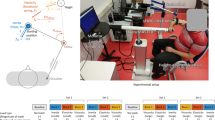Abstract.
This paper considers interaction of the human arm with “virtual” objects simulated mechanically by a planar robot. Haptic perception of spatial properties of objects is distorted. It is reasonable to expect that it may be distorted in a geometrically consistent way. Three experiments were performed to quantify perceptual distortion of length, angle and orientation. We found that spatial perception is geometrically inconsistent across these perceptual tasks. Given that spatial perception is distorted, it is plausible that motor behavior may be distorted in a way consistent with perceptual distortion. In a fourth experiment, subjects were asked to draw circles. The results were geometrically inconsistent with those of the length perception experiment. Interestingly, although the results were inconsistent (statistically different), this difference was not strong (the relative distortion between the observed distributions was small). Some computational implications of this research for haptic perception and motor planning are discussed.
Similar content being viewed by others
Author information
Authors and Affiliations
Additional information
Received: 12 February 1996 /Accepted in revised form: 6 May 1999
Rights and permissions
About this article
Cite this article
Fasse, E., Hogan, N., Kay, B. et al. Haptic interaction with virtual objects . Biol Cybern 82, 69–83 (2000). https://doi.org/10.1007/PL00007962
Issue Date:
DOI: https://doi.org/10.1007/PL00007962




